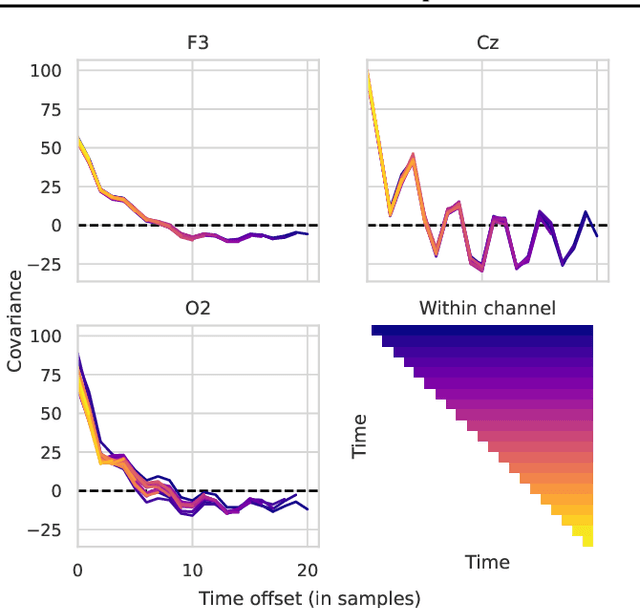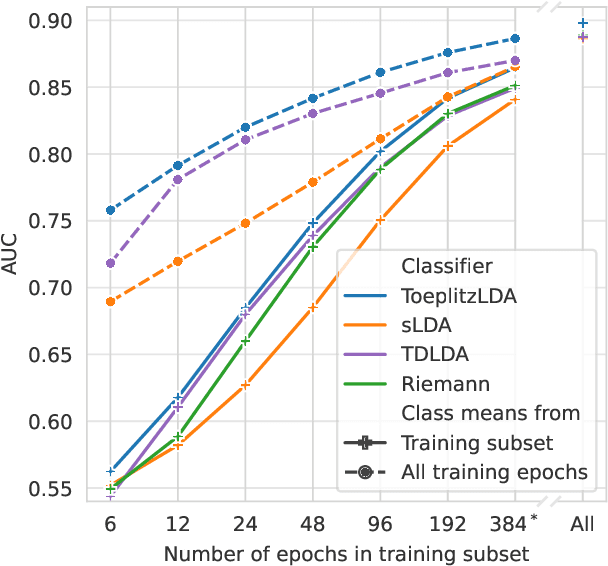Jan Sosulski
UMM: Unsupervised Mean-difference Maximization
Jun 20, 2023Abstract:Many brain-computer interfaces make use of brain signals that are elicited in response to a visual, auditory or tactile stimulus, so-called event-related potentials (ERPs). In visual ERP speller applications, sets of letters shown on a screen are flashed randomly, and the participant attends to the target letter they want to spell. When this letter flashes, the resulting ERP is different compared to when any other non-target letter flashes. We propose a new unsupervised approach to detect this attended letter. In each trial, for every available letter our approach makes the hypothesis that it is in fact the attended letter, and calculates the ERPs based on each of these hypotheses. We leverage the fact that only the true hypothesis produces the largest difference between the class means. Note that this unsupervised method does not require any changes to the underlying experimental paradigm and therefore can be employed in almost any ERP-based setup. To deal with limited data, we use a block-Toeplitz regularized covariance matrix that models the background activity. We implemented the proposed novel unsupervised mean-difference maximization (UMM) method and evaluated it in offline replays of brain-computer interface visual speller datasets. For a dataset that used 16 flashes per symbol per trial, UMM correctly classifies 3651 out of 3654 letters ($99.92\,\%$) across 25 participants. In another dataset with fewer and shorter trials, 7344 out of 7383 letters ($99.47\,\%$) are classified correctly across 54 participants with two sessions each. Even in more challenging datasets obtained from patients with amyotrophic lateral sclerosis ($77.86\,\%$) or when using auditory ERPs ($82.52\,\%$), the obtained classification rates obtained by UMM are competitive. In addition, UMM provides stable confidence measures which can be used to monitor convergence.
Introducing Block-Toeplitz Covariance Matrices to Remaster Linear Discriminant Analysis for Event-related Potential Brain-computer Interfaces
Feb 16, 2022



Abstract:Covariance matrices of noisy multichannel electroencephalogram time series data are hard to estimate due to high dimensionality. In brain-computer interfaces (BCI) based on event-related potentials and a linear discriminant analysis (LDA) for classification, the state of the art to address this problem is by shrinkage regularization. We propose a novel idea to tackle this problem by enforcing a block-Toeplitz structure for the covariance matrix of the LDA, which implements an assumption of signal stationarity in short time windows for each channel. On data of 213 subjects collected under 13 event-related potential BCI protocols, the resulting 'ToeplitzLDA' significantly increases the binary classification performance compared to shrinkage regularized LDA (up to 6 AUC points) and Riemannian classification approaches (up to 2 AUC points). This translates to greatly improved application level performances, as exemplified on data recorded during an unsupervised visual speller application, where spelling errors could be reduced by 81% on average for 25 subjects. Aside from lower memory and time complexity for LDA training, ToeplitzLDA proved to be almost invariant even to a twenty-fold time dimensionality enlargement, which reduces the need of expert knowledge regarding feature extraction.
 Add to Chrome
Add to Chrome Add to Firefox
Add to Firefox Add to Edge
Add to Edge